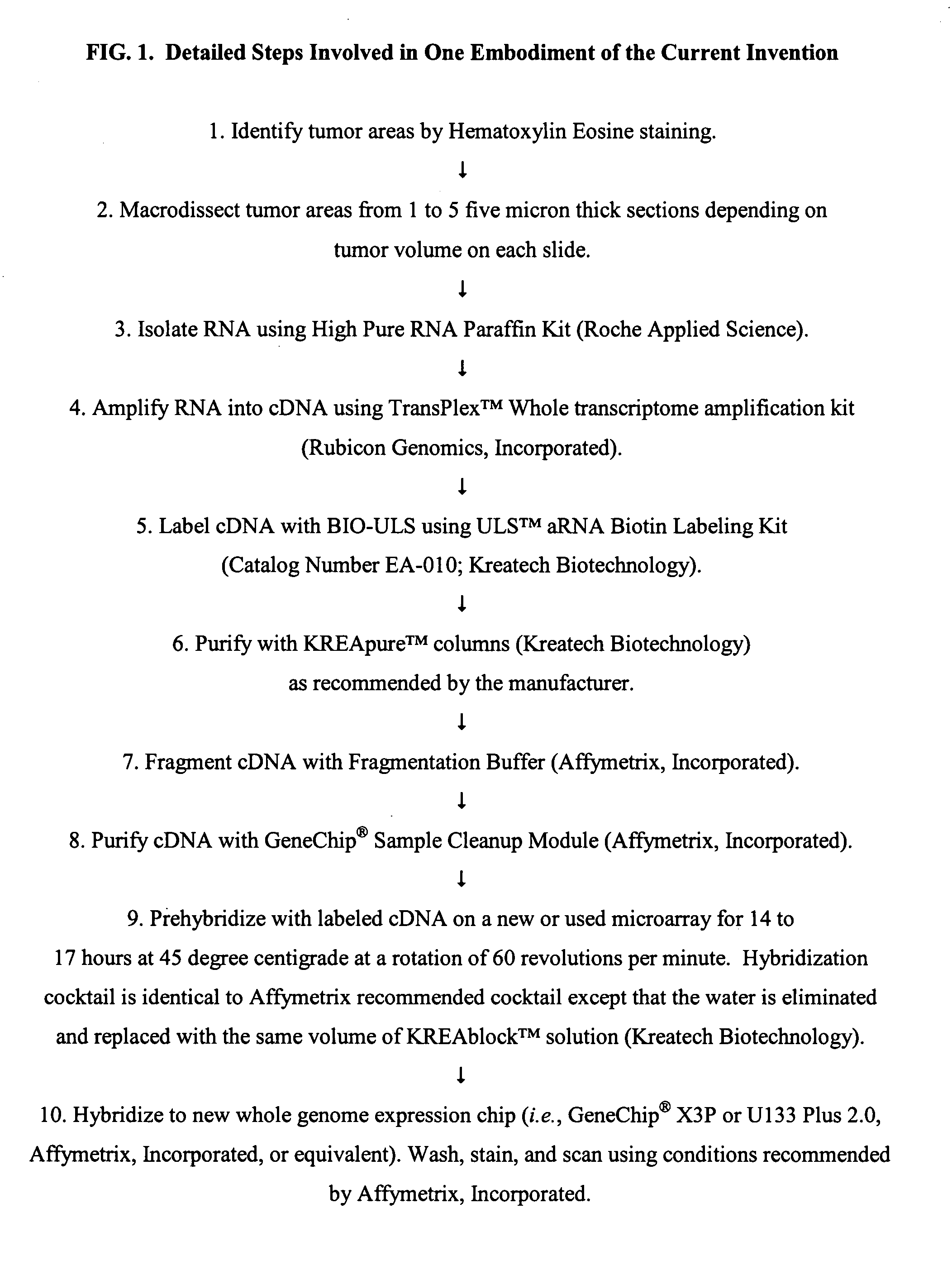Methods of whole genome or microarray expression profiling using nucleic acids prepared from formalin fixed paraffin embedded tissue
a technology of paraffin embedded tissue and microarrays, which is applied in the field of whole genome or microarray expression profiling using nucleic acids prepared from formalin fixed paraffin embedded tissue, can solve the problems of limiting the number of genes that can be interrogated in a single qrt-pcr experiment, underutilization of gene expression profiling studies, and affecting the efficiency of reverse transcription
- Summary
- Abstract
- Description
- Claims
- Application Information
AI Technical Summary
Benefits of technology
Problems solved by technology
Method used
Image
Examples
example 1
[0047] The effect of a pre-hybridization step on detection of specific gene signals in a subsequent hybridization on a high density gene expression array was tested by comparing the percent present call (proportion of probes on a microarray that yield meaningful above background data within each experiment) for 25 FFPET samples from breast cancer patients using a GeneChip® U133-X3P Array (Affymetrix, Incorporated) with and without pre-hybridization to a GeneChip® U133 Plus 2.0 Array (Affymetrix, Incorporated).
[0048] The methodology used in this study is outlined in FIG. 1. Briefly, the tumor area was identified in each of the 25 FFPET samples by hematoxylin-eosin staining, and the tumor areas were macrodissected from thin sections (1 to 5 microns thick, depending on the tumor volume) generated from each of the FFPET samples. RNA was isolated from the macrodissected tumor areas using the High Pure RNA Paraffin Kit (Roche Diagnostics Corporation, Roche Applied Science), following the...
example 2
[0052] In order to compare the methodology described in Example 1, above, with the Paradise™ Reagent System on RNA extractable from paraffin blocks that are more than one year old, the methodology described in Example 1, above, and the Paradise™ Reagent System were tested on fourteen FFPET tumor samples that were between 1 and 10 years old. Significance Analysis of Microarray (SAM), a widely used method to identify genes that are differentially expressed between two phenotypes (Tusher et al., Proc. Natl. Acad. Sci. USA 98:5116-5121, 2001), was used to see if the estrogen receptor (ER) gene ESR1, which is known to be differentially expressed between ER positive and ER negative tumors, could be identified as being a differentially expressed gene between ER positive and ER negative tumors in a dataset generated using the Paradise™ Reagent System, following the instructions provided by the manufacturer, and a dataset generated using the methodology described in Example 1, above. Of the ...
example 3
[0055] To prove that methods of the present invention also work with oligonucleotide arrays from Agilent Technologies, Incorporated, 16 FFPET samples from breast cancer patients were prepared as described in Example 1, above, and analyzed using oligonucleotide arrays from Agilent Technologies, Incorporated.
[0056] Using Significance Analysis of Microarray (SAM), as described in Example 2, above, 35 genes were found to be differentially expressed between estrogen receptor positive versus negative cases with false discovery rate of zero. The genes included multiple probes for estrogen receptor gene (ESR1) as well as other known ER related genes such as GATA3, AREG, MAPT, and GSTM3. The results are shown in Table 4.
TABLE 4NumeratorDenominatorGene SymbolScore (d)(r)(s + s0)Fold Changeq-value (%)ESR16.4747082615.04120.7785968625.945504810ESR16.4663403855.04710.7805129625.463813880ESR16.3406582634.88720.7707697424.278803060ESR16.1522700564.71340.7661298123.792583120TFF16.1505071315.9033...
PUM
| Property | Measurement | Unit |
|---|---|---|
| Time | aaaaa | aaaaa |
| Thickness | aaaaa | aaaaa |
| Fraction | aaaaa | aaaaa |
Abstract
Description
Claims
Application Information
 Login to View More
Login to View More - R&D
- Intellectual Property
- Life Sciences
- Materials
- Tech Scout
- Unparalleled Data Quality
- Higher Quality Content
- 60% Fewer Hallucinations
Browse by: Latest US Patents, China's latest patents, Technical Efficacy Thesaurus, Application Domain, Technology Topic, Popular Technical Reports.
© 2025 PatSnap. All rights reserved.Legal|Privacy policy|Modern Slavery Act Transparency Statement|Sitemap|About US| Contact US: help@patsnap.com



